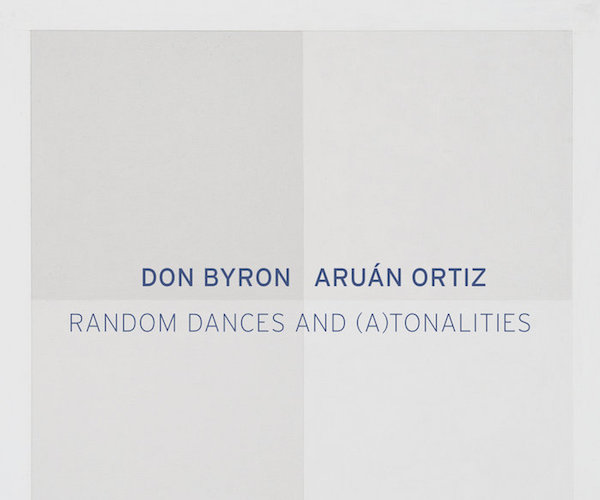Jazz CD Review: “Random Dances and (A)tonalities” — Ambitious Logic
Don Byron’s repertoire doesn’t just focus on the bebop era — nor is it self-consciously hip.
Don Byron and Aruán Ortiz, Random Dances and (A)tonalities (Intakt)

By Michael Ullman
I remember chatting with clarinetist and occasional tenor saxophonist Don Byron decades ago at a reception for the Boston Globe Jazz Festival. He told me, to my astonishment, that he was working on a record of the music of Mickey Katz. (This project became Don Byron Plays the Music of Mickey Katz, Elektra, 1993.) To me, Katz was the Yiddish comedian whose records include Borscht Riders in the Sky. Byron listened past the broad comedy and heard the music. At the New England Conservatory he studied with composer George Russell and played a wild clarinet in the Klezmer Ensemble.
Since then Byron has recorded compositions by Miles Davis, Ornette Coleman, and (repeatedly) Ellington, but also by Tchaikovsky, Chopin, Bach, and Puccini, Stevie Wonder, Raymond Scott, and Henry Mancini. I once spent a snowy afternoon at his house (then) in western Massachusetts where we watched Peter Gunn reruns. His repertoire doesn’t just focus on the bebop era — nor is it self-consciously hip. A clarinetist in a world of saxophonists, he seems drawn to the distinctive bounce and expressiveness of early jazz, reflected in his many Ellington recordings and such numbers as “Royal Garden Blues” (a favorite Louis Armstrong vehicle). His father took Byron to hear Duke Ellington, and those concerts had a lasting effect. Though he makes Ellington very much his own. It’s hard not to smile when listening (on his new disc, Random Dances and (A)tonalities) to Byron’s slinky version of Ellington’s 1927 composition “Black and Tan Fantasy.” It seems about to break into a tango.
Of course, Byron is also a composer of note. Many of his pieces contain political connotations or references: his “Sex/Work (Clarence/Anita)” from No-Vibe Zone is particularly relevant today. Byron’s compositions were immensely attractive to the young Cuban-born pianist Aruán Ortiz. In the notes to this new session of duets, Ortiz writes “I knew Don Byron’s approach before I knew him.” At first, Ortiz admired drummer Ralph Peterson’s compositions — then Peterson told the pianist he learned his technique from Byron. In the latter’s pieces Ortiz perceives “a particular and beautiful logic” that “spoke to my wildest ambitions.”
We hear those ambitions in Ortiz’s opening number, “Tete’s Blues.” (Ortiz calls his son Tete, after the Spanish jazz pianist Tete Montoliu.) The tune is hardly a traditional blues; it begins with an obsessively repeated yet offbeat rhythmic phrase in the right hand that is kept in check by a single repeated note in the left. Then Ortiz slows down, as if he’s run out of steam. Byron comes in with a theme that seems to wander disconsolately, though it is held together by its seductive opening phrase, a kind of sigh. Byron then solos: the repetitions in his lines seem inevitable, given the nature of the composition.

Don Byron (l) and Aruán Ortiz (r).
After “Tete’s Blues” comes the Ellington and, after that, a pleasant surprise: a version of a piece for solo piano by Spanish composer Federico Mompou, whose Musica Callada is a series of elegant miniatures: each seems to whisper a mysterious secret. Byron and Ortiz chose the piece crochet=54. It’s a metronome marking, but the tune — marked by a repeated note in the left hand — draws on simple, unforgettable melody that sounds a little like a plaintive bird call. Mompou’s piece is over in two minutes: Ortiz and Byron extend it. (For those who want to hear the original, I’d recommend Jordi Masó’s recording on Naxos.) They perform Byron’s “Joe Btsfkik,” this time with Byron on tenor, and then there’s one of the album’s highlights, “Dolphy’s Dance,” Geri Allen’s tribute to Eric Dolphy. Byron and Ortiz play the complicated melody in unison.
Byron performs a solo clarinet version (called “Double”) of a movement from Bach’s Partita in B Minor for solo violin. What happens next is remarkable. Byron’s “Delphian Nuptials” seems not merely to come after the Bach, but to follow from it. It makes use of a similar melodic structure, a tough-minded sequence of phrases. Yet, with gentle accompaniment by the pianist, “Delphian Nuptials” comes off as a softer, sweeter version of the Bach, a composition that seems to be humming to itself. On this track, Ortiz is the one who plays the blues.
Michael Ullman studied classical clarinet and was educated at Harvard, the University of Chicago, and the U. of Michigan, from which he received a PhD in English. The author or co-author of two books on jazz, he has written on jazz and classical music for The Atlantic Monthly, The New Republic, High Fidelity, Stereophile, The Boston Phoenix, The Boston Globe, and other venues. His articles on Dickens, Joyce, Kipling, and others have appeared in academic journals. For over 20 years, he has written a bi-monthly jazz column for Fanfare Magazine, for which he also reviews classical music. At Tufts University, he teaches mostly modernist writers in the English Department and jazz and blues history in the Music Department. (He plays piano badly.)
